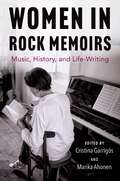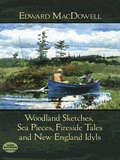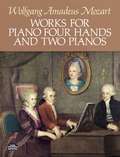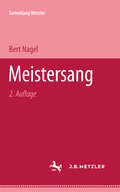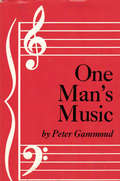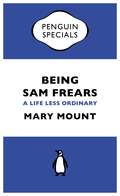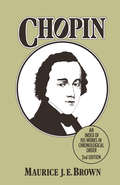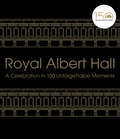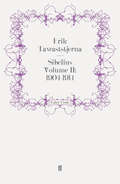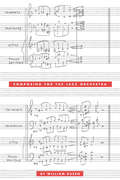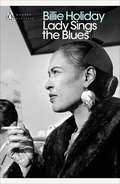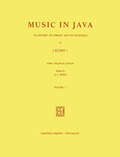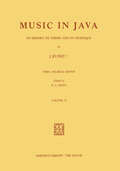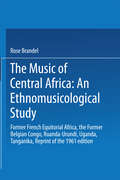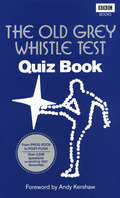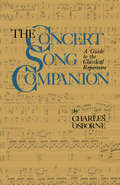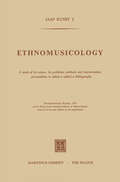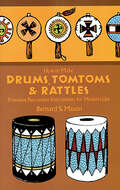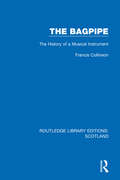- Table View
- List View
Women in Rock Memoirs: Music, History, and Life-Writing
Women in Rock Memoirs vindicates the role of women in rock music. The chapters examine memoirs written by women in rock from 2010 onwards to explore how the artists narrate their life experiences and difficulties they had to overcome, not only as musicians but as women. The book includes memoirs written by both well-known and lesser-known artists and artists from both inside and outside of the Anglo-American sphere. The essays by scholars from different research areas and countries around the world are divided into three parts according to the overall themes: Memory, Trauma, and Writing; Authenticity, Sexuality, and Sexism; and Aging, Performance, and the Image. They explore the dynamics of memoir as a genre by discussing the similarities and differences between the women in rock and the choices they have made when writing their books. As a whole, they help form a better understanding of today's possibilities and future challenges for women in rock music.
Woodland Sketches, Sea Pieces, Fireside Tales and New England Idyls
by Edward MacDowellEdward MacDowell (1860-1908) was America's most prominent nineteenth-century composer. Championed by Franz Liszt, he was one of the first U.S. composers to gain international recognition. A leading exponent of the Romantic tradition, he was a prolific composer for the piano. This outstanding collection presents his best, most characteristic works, reprinted from original editions. They include:Woodland Sketches, Op. 51Sea Pieces, Op. 55Fireside Tales, Op. 61New England Idyls, Op. 62These beautiful and affecting compositions reflect not only MacDowell's poetic Romanticism but also his virtuosic skills as a pianist, which won him an international reputation as a concert artist. Intermediate- and advanced-level pianists will appreciate the lyric intensity and ebullient spirit of these pieces.
Words and Music (Liverpool Music Symposium #3)
by J. G. WilliamsonWord and music studies is a relatively young discipline that has nonetheless generated a substantial amount of work. Recent studies in the field have embraced music in literature (word music, formal parallels to music in literature, verbal music), music and literarature (vocal music) and literature in music (programme music). Other positions have been defined in which song exists as an analysable category distinct from words and music and requiring its own grammar. Much of the literature has tended to focus on readings of the literary text, pushing theoretical and analytical concerns in music to one side, a trend that is as apparent among musicologists as among literary historians. The essays presented here from the third Liverpool Music Symposium seek accordingly to redress this situation. Contributors tackle the study of words and music from a number of standpoints, examining artists as diverse as Eminem, Patti Smith and Arnold Schoenberg.
Works for Piano Four Hands and Two Pianos (Dover Music For Piano Ser.)
by Wolfgang Amadeus MozartFrom his earliest years. Mozart played piano duets with his sister, and as his musical career progressed he created a small repertoire of masterly four-hand piano compositions that are among the most admired and performed in this distinctive genre.This Dover edition presents six of these choice works, plus two compositions Mozart wrote for two pianos all reprinted from the authoritative Breitkopf & Härtel edition: Sonatas in D Major (K.381/123a), B-flat Major (K.358/186c), F Major (K.497), G Major (K.497a and 500a), and C Major (K.521) and Theme and Variations in G Major (K.501). Also for 2 pianos: Sonata in D Major (K.448/375a) and Fugue in C Minor (K.426). Duet enthusiasts will discover in these charming works the sparkling elegance, varied moods, and fluid textures that constitute the very essence of Mozart's musical personality.
One Man's Music
by Peter GammondOne Man's Music is a love story - the story of Peter Gammond's relationship with music from earliest childhood. The growth of the relationship is, has been - and still is - deltaic, branching out through every phase and aspect of Western European and North American music: classical, light, jazz and even pop. Despite its range and depth, the book is not the least degree a textbook or scholarly treatise. But is: HISTORICAL neither formally nor chronologically but ranging through the key developments in all periods of music; CRITICAL it makes no pretence to be comprehensive but deals with many individual composers and styles; WIDE-RANGING It examines all types of music from classics to pop: orchestral music, church music, opera, musical comedy, popular music and jazz; PERSONAL the approach is frankly individual, often autobiographical; ENTERTAINING. the subject matter is fascinating and the style - with more than a sprinkling of satirical humour - is extremely engaging; KNOWLEDGEABLE the personal approach is complemented by a wealth of reference material of a catholic and unpredictable nature. Aged 93, Peter lives in Shepperton with his wife Anna where they still enjoy listening to music.
The operas of Leos Janacek: The Commonwealth and International Library: Music Division
by Erik ChisholmThe Operas of Leoš Janáček presents the comprehensive analysis of Leoš Janáček's operas. This book presents a concise account of Janáček's extraordinary musical background and development as an operatic composer. Organized into seven chapters, this book begins with an overview of Janáček's visit to the London Zoo in 1926, which profoundly influenced his very personal compositional style when he recorded the different cries and sounds of animals in musical notation. This text then describes the nature of Janáček's last two operas, which are characterized by emotional stresses, psychological conflicts, and the turbulence of text and music. Other chapters describe pastoral symphony of the opera The Cunning Little Vixen, which is a touching and sincere tribute to the basic unity of all living creatures of nature. This book discusses as well the characteristic explosive musical prose writing of Janáček. This book is a valuable resource for musicians, instrumentalists, and composers.
Being Sam Frears: A Life Less Ordinary (Penguin Specials)
by Mary MountThis is Sam Frears' story.This is also the story of an actor, a rock-climber and a man born with an extremely rare genetic disorder only affecting Ashkenazi Jews. Sam was supposed to live to the age of 5. In February, he celebrated his 40th birthday.Challenged by blindness and a body under great stress, Sam Frears is trying to live an ordinary life under extraordinary circumstances His struggles and triumphs offer an illuminating look at the differences - and similarities - that make us human. For those who enjoyed My Left Foot and Stuart: A Life Backwards, this Penguin Special offers a fresh look at what it's like to be Sam.
Royal Albert Hall: A celebration in 150 unforgettable moments
by Royal Albert HallThe most iconic concert hall in the world celebrates 150 years with a stunning review of history's finest performances and performers. Opening with a personal letter from Queen Elizabeth II, this beautiful book celebrates 150 moments that have shaped The Royal Albert Hall over the last century and a half. From The Beatles to the Suffragettes, Albert Einstein to Winston Churchill, Mohammed Ali to B.B. King, few other buildings have housed such a stunning variety of era-defining people and events.This gorgeous, illustrated guide takes you behind the scenes of one of the most well-loved concert halls in the world, offering insights into the building’s iconic architecture, as well as its lesser-known quirks such as the reinforced toilets designed for Sumo wrestlers. This book features events ranging from the world's first sci-fi convention in 1891 to the annual Cirque du Soleil, which requires the auditorium to be transformed into a gymnasium. Autographs and candid comments from incredible performers who have appeared on its stage, like Russell Howard, Eric Clapton and Katie Derham, give a unique insider’s perspective on an esteemed and beloved British institution. With never-before-seen images, insights and more, this is the ultimate celebration of a British architectural icon which continues to inspire artists and audiences from around the world.
Sibelius Volume II: 1904-1914
by Erik TawaststjernaErik Tawaststjerna embarked on his monumental and acclaimed study of Jean Sibelius's life and music in 1960 and it occupied him for over a quarter of a century. His study differs from other work on the composer in one important respect: he had unrestricted access to the composer's papers, diaries and letters as well as the advantage of numerous conversations with the composer's widow and other members of the family. Thus his researches can justifiably claim to have thrown entirely fresh light on the great Finnish composer. Far from the remote personality of the Sibelius legend, Sibelius emerges as a highly colourful figure. This second volume covers the crucial period from 1904 and the beginning of the Third Symphony through to the outbreak of the First World War ten years later. During this period Sibelius began keeping a diary which, together with his letters to his wife, Aino, and to his friend, Axel Carpelan, helped the author give us a day-by-day, intimate account of the turbulent years that saw the gestation and completion of many of his finest works, culminating in the Fourth Symphony. Translated by Robert Layton, himself a Sibelius specialist, this is a compelling and insightful account of the music of one of the twentieth century's greatest composers.
Composing for the Jazz Orchestra
by William Russo"Although it will be of primary interest to those who are engaged in composition themselves, [this] book is also recommended for readers who may wish to gain further insight into just what makes jazz composition so different from traditional approaches."—Malcolm Bessom, The Music Magazine
Composing for the Jazz Orchestra
by William Russo"Although it will be of primary interest to those who are engaged in composition themselves, [this] book is also recommended for readers who may wish to gain further insight into just what makes jazz composition so different from traditional approaches."—Malcolm Bessom, The Music Magazine
Composing for the Jazz Orchestra
by William Russo"Although it will be of primary interest to those who are engaged in composition themselves, [this] book is also recommended for readers who may wish to gain further insight into just what makes jazz composition so different from traditional approaches."—Malcolm Bessom, The Music Magazine
Composing for the Jazz Orchestra
by William Russo"Although it will be of primary interest to those who are engaged in composition themselves, [this] book is also recommended for readers who may wish to gain further insight into just what makes jazz composition so different from traditional approaches."—Malcolm Bessom, The Music Magazine
Lady Sings the Blues: Lady Sings The Blues (Penguin Modern Classics)
by Billie Holiday"I've been told that no one sings the word 'hunger' like I do. Or the word 'love'."Lady Sings the Blues is the inimitable autobiography of one of the greatest icons of the twentieth century. Born to a single mother in 1915 Baltimore, Billie Holiday had her first run-in with the law at aged 13. But Billie Holiday is no victim. Her memoir tells the story of her life spent in jazz, smoky Harlem clubs and packed-out concert halls, her love affairs, her wildly creative friends, her struggles with addiction and her adventures in love. Billie Holiday is a wise and aphoristic guide to the story of her unforgettable life.
Music in Java: Its History, Its Theory and Its Technique
by J. KunstOne day in the summer of 1921 a postal delivery brought me a little packet of reprints from the periodical "Djawa" : articles about Indonesian music by Dr. JAAP KUNST, which until that moment had not come to my notice. A cursory glance was enough to convince me that the author was a very gifted man, who had made a sound and absolutely scientific study of the subject, and thereby made a valuable contribution, by means of careful observation and actual tone-measurements, to the facts known from the older studies by GRONEMAN, LAND and ELLIS. These measure ments were particularly satisfying to me personally, since they constituted an astonishing confirmation of a hypothesis concerning the genesis of tone systems (through the "cycle of blown fifths"), which I had propounded two years previously, without, however, having published it. At the same time it was proved, through the perfect conformity existing between the measured and the theoretical absolute pitches (vibration frequencies), that Indonesian gamelan tuning, too, belongs to the radius of ancient Chinese culture - much the same as is the case with Pan-pipes and xylo phones all over· the world. The first contact between Dr. KUNST and myself led to a regular cor respondence, which especially contributed to a further development of the above-mentioned theory of tone-systems.
The Music of Central Africa: Former French Equatorial Africa the Former Belgian Congo, Ruanda-Urundi Uganda, Tanganyika
by R. BrandelUnder the inspiring guidance of my mentor, Curt Sachs, this work was conceived, planned, and executed. It gained in dimension under the acute and patient perusal of Gustave Reese to whose brilliant propensity for clarity of thought and of style lowe a huge debt. Furthermore, the helpful suggestions made by Martin Bernstein and by Jan LaRue are gratefully acknowledged. If Jaap Kunst had not kindly gone to the trouble of ordering, supervising the con struction of, and mailing to me from Amsterdam his personally designed monochord, an important section of this work could not have taken form. This preface is not complete, of course, without final thanks to my husband, Harvey B. N atanson, for his sustained interest and encouragement. R. B. Note As the present work goes to press, the political map of Africa is flowing into a new mold. Several countries have obtained independence, and new names and data should be con sidered: French Equatorial Africa has become (November 28-December I, 1958) four independent countries - Republic of the Congo: Brazzaville (formerly Middle Congo), Gabon Republic (formerly Gabon), Central African Republic (formerly Ubangi-Shari), and Republic of Chad (formerly Chad). The Belgian Congo has become (June 30, 1960) the Republic of the Congo: Leopoldville.
The Old Grey Whistle Test Quiz Book
by Mark PaytressBob Dylan. Tom Waits. Blondie. The Ramones. REM. The Who. Fleetwood Mac. Led Zeppelin. The list goes on and on.The Old Grey Whistle Test has played host to some of the biggest names in music and has assumed its rightful place at the pinnacle of rock history - but how much of a fan are you?Do you know your Bowie backlist? Could your knowledge of Lennon long-players stand up to scrutiny? And can you tell your glam rock from your hair metal? This collection delves deep into the Whistle Test archives to pose over 2,500 quiz questions on your favourite artists, from global megastars to obscure one-time guests on the show. Play in teams or test your own knowledge on questions covering a whole range of musical puzzles, from lost albums and banned songs to classic solos, one-hit wonders and more.
The Concert Song Companion: A Guide to the Classical Repertoire (Quality Paperbacks Ser.)
by Charles OsborneW HAT I H A V E attempted in this book is a survey of song; the kind of song which one finds variously described as 'concert', 'art', or sometimes even 'classical song'. 'Concert song' seems the most useful, certainly the least inexact or misleading, of some descriptions, especially since 'art song' sounds primly off putting, and 'classical song' really ought to be used only to refer to songs written during the classical period, i. e. the 18th century. Concert song clearly means the kind of songs one hears sung at concerts or recitals. Addressing myself to the general music-lover who, though he possesses no special knowledge of the song literature, is never theless interested enough in songs and their singers to attend recitals of Lieder or of songs in various languages, I have naturally confined myself to that period of time in which the vast majority of these songs was composed, though not necessarily only to those composers whose songs have survived to be remembered in recital programmes today. I suppose this to be roughly the three centuries covered by the years 1650-1950, though most of the songs we, as audiences, know and love were composed in the middle of this period, in other words in the 19th century.
Ethnomusicology: A study of its nature, its problems, methods and representative personalities to which is added a bibliography
by E.D KunstThis booklet hardly needs a preface; the contents, I think. speak for themselves.It contains a short and carefully brought up to date resume of all that I. as a private University Lecturer in Amsterdam. have tried to teach my pupils. It is intended as a general introduction to ethnomusicology, before going on to the study of the forms of separate music-cultures. I sincerely hope that those, who wish to teach themselves and to qualify in this branch of knowledge, will find a satisfactory basis for selftuition in the matter here brought together. Regarding the possibility of a new edition, any critical remarks or infor mation as to possible desiderata would be very gratefully received. J.K. PREFACE TO THE SECOND EDITION My request for critical remarks and desiderata has not been ignored. My sincere thanks to all who took the trouble to let me know what they missed in my booklet. Through their collaboration the contents have undergone a considerable improvement and enlargement as compared to the original edition issued in 1950 by the Royal Tropical Institute, Amsterdam. under the title 'Musicologica'. I have taken care to add many particulars from non-European sources. with the result that now the book is no longer so Europe-centric as it was. Furthermore, I have done my best to mention in a special bibliography all the more important ethnomusicological publications, with the exception of those issued in the Russian, Arabic. Chinese, Indonesian, Javanese.
How to Make Drums, Tomtoms and Rattles: Primitive Percussion Instruments for Modern Use
by Bernard MasonMaking your own primitive instruments from simple materials such as coffee cans and flower pots. Includes 121 figures.
The Bagpipe: The History of a Musical Instrument (Routledge Library Editions: Scotland #9)
by Francis CollinsonOriginally published in 1975, and written by an authority on Scottish music, this book traces the evolution of the bagpipe whilst also narrating the fortunes of the ‘Great Highland Bagpipe’ itself. Exploring history and archaeology of civilizations as far removed from the Scottish Highlands as Egypt and Mesopotamia, Greece and Rome this book offers a unique full-length history of one of the world’s most interesting and ancient musical instruments. Appendices list the bagpipes of other countries and the materials used in the instrument’s manufacture as well as a comprehensive bibliography.
The Bagpipe: The History of a Musical Instrument (Routledge Library Editions: Scotland #9)
by Francis CollinsonOriginally published in 1975, and written by an authority on Scottish music, this book traces the evolution of the bagpipe whilst also narrating the fortunes of the ‘Great Highland Bagpipe’ itself. Exploring history and archaeology of civilizations as far removed from the Scottish Highlands as Egypt and Mesopotamia, Greece and Rome this book offers a unique full-length history of one of the world’s most interesting and ancient musical instruments. Appendices list the bagpipes of other countries and the materials used in the instrument’s manufacture as well as a comprehensive bibliography.
